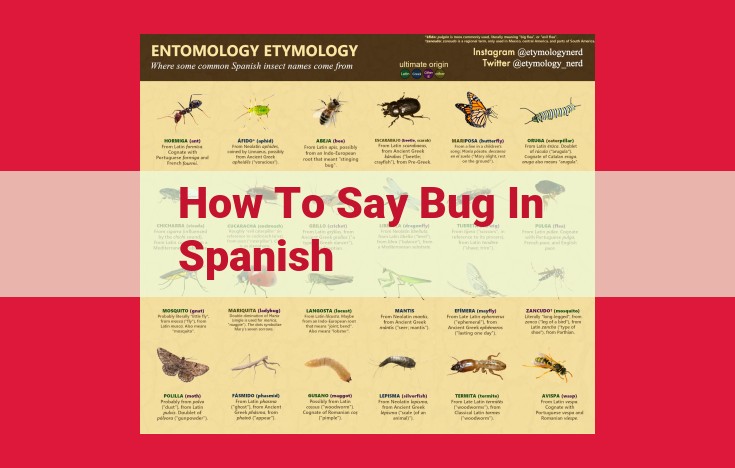
Explore The World Of Insects: Taxonomy, Entomology, And Impact On The Environment
Insects, fascinating creatures with diverse characteristics, inhabit our planet in abundance. The Spanish language offers various terms to describe these creatures: "insecto" refers to insects in general, while specific bugs like crickets are "grillo," stink bugs are "chinche," and cockroaches are "cucaracha." Entomology, the study of insects, provides valuable insights into their biology and behavior. Bug sprays, bug zappers, and bug collectors play crucial roles in controlling or studying these creatures. Understanding insects and their connections to non-living entities deepens our knowledge of the natural world and its ecological importance.
The Enchanting Realm of Insects: Unraveling Their World and Interconnections
In the vast tapestry of nature, a captivating realm unfolds – the realm of insects. With their diverse characteristics and intricate behaviors, insects paint a vibrant canvas that both fascinates and intrigues. They are the architects of ecological balance, the unsung heroes of pollination, and the source of endless scientific discoveries.
But their world extends beyond their living forms. Insects have inspired a plethora of non-living creations that have shaped our understanding and interaction with them. From the scientific discipline of entomology to the practical tools like bug sprays and zappers, humans have sought to unravel the mysteries and control the presence of these tiny creatures.
Entomology, the study of insects, has unlocked the secrets of their biology and behavior. Through meticulous observation and experimentation, entomologists have illuminated the complex interactions between insects and their environment, paving the way for innovative pest control strategies and the conservation of threatened species.
Types of Insects
The insect world is a teeming metropolis inhabited by a myriad of captivating creatures. From the minuscule to the colossal, each species displays its own unique charm and significance. In this section, we'll delve into the fascinating world of five specific insects: insects, bicho, grillo, chinche, and cucaracha.
Insects
The term "insect" encompasses an incredibly diverse group of organisms that share a common set of characteristics. These tiny wonders typically possess six legs, an exoskeleton (a sturdy outer shell), and a body divided into three segments: head, thorax, and abdomen. The insect world boasts over a million known species, making them the most abundant group of animals on Earth.
Bicho
In Spanish-speaking countries, the word "bicho" is a general term for insects. It can refer to a wide range of creatures, including beetles, ants, and spiders. However, in some regions, "bicho" is specifically used to describe ladybugs. These delightful insects come in a variety of colors and patterns and are often considered symbols of good luck.
Grillo
The chirping cricket (grillo) is a common sight and sound in many parts of the world. These insects are known for their nocturnal behavior and their distinctive "cri-cri" call. Crickets play a crucial role in the ecosystem as they serve as food for birds, reptiles, and other animals.
Chinche
The bed bug (chinche) is a small, flat insect that feeds on human blood. These pesky creatures can infest homes and cause discomfort with their bites. Bed bugs are often associated with poor sanitation, but they can also spread through contact with contaminated furniture or clothing.
Cucaracha
The cockroach (cucaracha) is one of the most resilient and adaptable insects in the world. These creatures can survive in a wide range of conditions and are known for their persistence. Cockroaches are often considered pests, but they also play a role in the ecosystem as scavengers and decomposers.
Non-Living Entities Related to Insects
Insects, the diverse creatures that inhabit our planet, have sparked human curiosity and ingenuity, leading to the development of various non-living entities that enhance our understanding and interaction with these fascinating creatures.
Entomology: Unlocking the Secrets of Insect Life
Entomology, the scientific study of insects, plays a crucial role in unraveling the mysteries of insect biology and behavior. Entomologists meticulously observe, classify, and experiment with insects to gain insights into their intricate life cycles, communication systems, and ecological niches. By studying the complex interactions between insects and their environment, scientists can develop targeted pest management strategies, promote pollination, and contribute to our overall understanding of the natural world.
Bug Sprays: A Battle Against Insect Invasions
Bug sprays, armed with potent chemical formulas, have become a staple in human households. These sprays effectively neutralize insects upon contact, offering a quick and convenient solution to unwelcome pest incursions. With a variety of active ingredients available, from potent pyrethroids to natural repellents like citronella, bug sprays provide flexibility in tailoring your defense against specific insects. Remember to follow safety precautions and choose products appropriate for your environment when using bug sprays.
Bug Zappers: Electrifying Insect Extermination
Bug zappers, with their distinctive electrical grids, lure insects with ultraviolet light and swiftly incapacitate them with a powerful shock. These devices are particularly effective against flying pests like mosquitoes and moths, providing a hygienic and low-maintenance solution for outdoor gatherings or indoor spaces. However, caution should be exercised to prevent the accidental zapping of beneficial insects like bees or butterflies.
Bug Collectors: Preserving the Wonders of the Insect World
Bug collectors, ranging from simple to intricate designs, serve as invaluable tools for both scientific research and insect enthusiasts. These devices allow users to capture and preserve specimens for detailed study or display, contributing to our understanding of insect diversity and promoting appreciation for the intricate beauty of these creatures. Hobbyists and professionals alike use bug collectors to expand their collections, document insect distributions, and contribute to scientific knowledge.
Related Topics:
- Translation For “Ears” In Spanish Not Provided In Given Context
- How To Teach In Spanish: A Comprehensive Guide To Using The Verb “Enseñar”
- Understanding The Nuances Of “País” In Spanish: Key Terms For Country And Nation
- Effective Spelling Strategy: Decomposing “Peanut” Into Phonetic Components
- How To Express Silence In Spanish: Nouns, Verbs, Adjectives, And Phrases